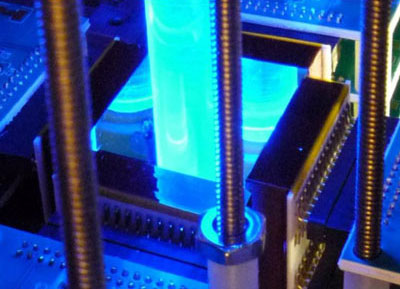| Jan 28, 2015 |
A new instrument to study the extreme universe - the X-Ray polarimeter X-Calibur
|
|
(Nanowerk News) What are the high-energy processes in the Universe that occur in the immediate vicinity of a black hole? To study a question like this one cannot simply utilize a high-resolution telescope. Even with the best available telescopes, it is difficult or even impossible to directly resolve the regions of interest and the energies emitted from such objects extend to much higher energies, e.g. X-rays. The astrophysics research group at Washington University in St.Louis built an instrument that is capable to measure the polarization properties of X-rays. This instrument, once flown in space, can be used in a novel approach to study the most extreme objects in the Universe, such as black holes and neutron stars.
|
 |
| The X-ray beam enters the scattering slab (blueish glow) from the top. The X-rays are scattered in the slab with a scattering distribution characteristic depending on the polarization properties of the incoming beam. The scattering distribution is measured with semiconductor X-ray detectors surrounding the scattering slab on all four sides. The digitized signals are received through the readout electronics that are attached at the back-side of each detector. (Image: JAI)
|
|
Only the most extreme objects in the universe are capable of producing high-energy particles and emit radiation with energy in the X-ray band and above. However, the regions of interest (black hole vicinities, formation zones of relativistic plasma jets, etc.) are too small to be spatially resolved with purely imaging instruments. The solution is to perform indirect measurements of those regions using the polarization properties of the emitted radiation - such as the orientation of the electric field vector of the X-ray photons. Such observations are regularly performed at radio and optical wave bands, but sensitive polarization techniques have not yet available for observations at X-ray energies - needed to study the most extreme objects in the Universe.
|
|
The astrophysics research group at Washington University, led by Prof. Krawczynski and Prof. Beilicke, designed, built, and tested an X-ray polarimeter named X-Calibur. This instrument, once flown in space or as a scientific balloon payload, will be capable to study the energetic environments very close to the black hole.
|
|
"Only five years ago, we came up with the first design of the X-Ray polarimeter," Assistant Professor Matthias Beilicke said, "two years later we had a working prototype module and now the full instrument is ready to fly on an astrophysics mission." "We are planning to have a scientific test flight of the instrument as a balloon payload at an altitude of >120,000 feet in the year 2016," Prof. Krawczynski said.
|
|
This research is published in the Special Issue on Scientific Balloon Capabilities and Instrumentation, in the Journal of Astronomical Instrumentation ("Design and Performance of the X-ray Polarimeter X-Calibur").
|

